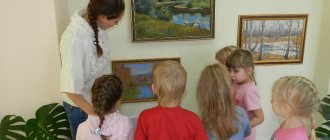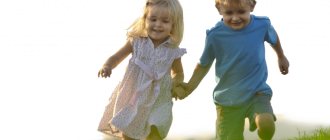Aesthetic education is implemented at every stage of personal development. It becomes more effective the earlier the child enters the sphere of targeted aesthetic influence, which should be uniform and combine all activities, any aspects of his life.
The aesthetic education system is aimed at:
- Creating in children a set of elementary knowledge and impressions, on the basis of which an interest in aesthetic phenomena and artistic objects is formed.
- Development of abilities for aesthetic experiences, formation of personality qualities that will allow one to appreciate highly artistic objects and phenomena and provide the opportunity to enjoy their contemplation and possession.
- Awakening creative abilities in students. An aesthetically developed personality becomes an active creator, trying to bring his life and everything that surrounds him into submission to the learned canons of beauty.
The main wealth for society is a creative personality
In everyday work, in everyday life, and in communication, adults and children encounter aesthetic phenomena. There is beauty and ugliness everywhere. It has a tragic and comic influence on different areas of life. Beauty pleases, stimulates activity, ugliness repels. Comic phenomena help you see shortcomings, tragic phenomena make you sympathize.
Aesthetic education opens the child’s soul to new forms, sounds, colors, helps a deeper understanding of the world, and promotes harmonious development and self-discovery. Developed creative thinking contributes to the search for new ways, including in the field of science, economics, and production.
The tasks of society bring to the fore new demands on people. Since it becomes the main component of the productive forces, it must be fully developed. It is impossible to educate a creative person who has the need for creative activity without the efforts of society and policies specifically aimed at this. Therefore, the most important means of qualitative development of human nature is aesthetic education from a very early age.
Read: Means of aesthetic education.
Principles of aesthetic education
Creative abilities must be developed from birth. From early childhood, one must instill good taste and develop the need to communicate with the sublime. Aesthetic education is aimed at developing the ability to see beauty and following the rules of good behavior, experience of friendly relations with others. Its basis is the following principles:
- Interaction. Any action should strive for aesthetic perfection: communication with peers, nature, objects of art, independent household and work activities.
- A complex approach. Education gives tangible results if creative activity is based on interdisciplinary connections and connects various types of art.
- Socialization. Aesthetic and artistic activity is not divorced from life. This is how students develop an adequate attitude towards their environment; they will be able to find beauty in its various manifestations.
- Systematicity. General and aesthetic development are interconnected. With this approach, the emotional sphere and all cognitive processes develop harmoniously.
- Independent creativity. The method of aesthetic education is most effective when applied to preschool children if they master some creative activities themselves: dancing, drawing, sculpting or singing in a choir.
- Aesthetics should dominate all life. Little children need to live in beauty. The main educational meaning is to understand the importance of accuracy and politeness. Proper aesthetic development is influenced by the beauty of the room and clothing.
- The age of the student is taken into account. Educational means are selected according to age. The formation of personality in more mature years depends on how correctly aesthetic perception was formed in younger schoolchildren.
Aesthetic education in a preschool educational institution
Principles
What helps a child to better and faster understand the culture of his country and understand what is considered beautiful in the world? These criteria include:
- Situation. Children need to see a beautiful room. A good renovation of an apartment is needed not only to demonstrate it to guests. A child should grow up in a room that will inspire him to develop his creative abilities. This doesn't just apply to his room. The premises of the kindergarten should also contribute to the development of good aesthetic taste in children.
- Independent activity. Children's creativity cannot be limited. Of course, he needs to be directed in the right direction and the boundaries of what is permitted explained. But you shouldn’t criticize the kid’s work. Children learn about the world through images. Everyone's perception is different, so the result of the activity will also be different. Parents should support any creative initiative of the child and help him in the implementation of his planned projects.
- Management of activities. Parents should not stand by and watch their child do stupid things. If your child decides to draw on the wallpaper, you need to scold the child. There is a fine line between creativity and permissiveness that cannot be crossed. At first, parents should always set the rules of the game. Children must connect to the game and upgrade it as they wish. Parents must ensure that the child does not cross the boundaries of reason.
Forms of organization of aesthetic education
Methods of artistic and aesthetic education have the best results when they are interconnected. Teachers should combine and vary them.
The methods differ in:
- methods of transmitting information;
- practical form of organization.
The methods are divided into:
- visual (when children get acquainted with examples of art);
- verbal (adults tell, explain);
- practical (testing, creative work).
Visual methods (looking at a picture, listening to a piece of music together) suggest the emotional content of the moment. An acquaintance with objects of art should make a vivid impression on the child so that it is remembered.
The form of organization is as follows:
- when adults show an example of an action, they invite the child to repeat a poem or sing a song;
- Teachers invite the child to independently determine how to complete the task: sculpt, cut, or draw something.
It must be remembered that the aesthetic education of preschoolers is somewhat different from the methods of working with school-age children. For children, the emphasis is placed on visual perception; they are gradually brought to realize the importance of cleanliness and order. Older children are able to express their creativity. Preschoolers learn to evaluate, and schoolchildren are already creating a product and have a creative approach in the process of creating an object.
Methods of aesthetic education
The main methods that promote the development of children’s aesthetic senses, the ability to evaluate, and creatively apply acquired knowledge and skills include:
- Method of persuasion. It is used only when the phenomenon being studied is beautiful. Pupils have an emotional response when meeting works of art and participating in a holiday. The method can be considered equally verbal, because Children's observations receive commentary from an adult and awaken thoughts and feelings.
The teacher must select the most impressive works of art and take care of the appropriate mental mood of the children. The subject must be well mastered by the teacher, and the speech must be precise and expressive. When attention is focused on the beautiful, the teacher gives the concept of “what is good and what is bad.”
- Training method. It implies a practical action, an exercise aimed at changing the environment, instilling socially accepted cultural behavior skills. The content of the method is to teach the child to see and appreciate beauty, and to act accordingly.
Systematic exercises and children's artistic practice promote children's activity.
- Method of problem situations. Allows creativity and the desire to act to awaken. The teacher invites the students to find a way to realize their artistic idea themselves. For example, after listening to a fairy tale, children are asked to portray one of the characters. The task can be simple or complicated by the poor choice of the hero. The child learns to think on his own, comes to an independent decision on how best to realize his plans: draw, sculpt, compose a poem.
- Encouraging empathy. A sympathetic person who knows how to empathize and compassion experiences joy from communicating with people, and celebrates successes and victories with them. Children who can sympathize are more open and friendly, they have more friends, and they are less likely to find themselves in conflict situations.
Emotional reading of fairy tales, discussion of illustrations, a puppet show or a musical number will help here.
Traditional methods of influencing students
Story. It should be emotional, have a plot outline, be educational, influence the imagination, but not interfere with self-assessment.
How to teach a child to dance: easy dances for beginners
Lecture. Dedicated to more complex topics, it is appropriate for classes with older children. Equipping the lesson with visual material will give greater imagery. It is permissible to raise problematic topics, push students into discussion, and persuade them to express their point of view.
Conversation. This is not a teacher’s monologue in front of children, but a mutual emotional exchange of opinions. During the conversation, the teacher uses visual material, interprets scientific concepts, emphasizes certain beautiful characteristics in works of art, work, real and fictional characters in literature, theater, and cinema.
Dispute. Designed to discover and bring together different points of view, raise a problem, and attract children to discuss it. The task of adults is to carry out serious preparatory work to help identify positions, stimulate dialogue, and direct the dispute into a cultural direction.
Education through art
Whatever the methods of education, it is important that they are provided with the necessary conditions:
- developmental environment;
- close interaction with nature and art;
- conditions for the realization of creativity.
At a young age, aesthetic education is distinguished by the fact that children perceive everything around them with their senses. For them, the form and content of an object are inseparable. If a child likes something, he experiences delight and joy. The teacher’s task is to direct this simple mental movement from ordinary perception to a deep understanding of harmony, beauty, and the formation of aesthetic taste.
Important
Proper musical and aesthetic education teaches children not only to understand beauty, but also to find beauty in everyday life: everyday phenomena, nature, work, clothing.
Tasks
The goals of cultural education of children are clear. What methods and tasks of aesthetic education exist? Experts highlight the following:
- Personality formation. A person must be diversified. This is what will help him feel complete in the future. If there is a gap in any area during the formation of personality, a person may experience depression about his inferiority. Parents always devote more time to the physical and intellectual development of the child than to aesthetic education. That is why, in general, the level of culture is becoming lower every year. What could this lead to? Moral values are falling, ideals are crumbling. As a result, man gradually descends to a primitive level.
- Formation of the ability to see beauty. A person must be able to look at the world positively. It is this ability that will help him in the future to overcome all life’s problems and troubles. This does not mean that you need to put on rose-colored glasses, but it does mean that the attitude that a person internally gives himself will be positive.
- Development of taste. Today people are trying to replace ideals. In order not to feel stupid and not exchange glass for gold, as the natives did, each individual must have a developed concept of beauty that will correspond to established canons.
- Stimulating creativity. A creative person is able to live an interesting life and create something new. Creativity, good imagination and fantasy work wonders. To develop these areas of thinking, you need to engage in aesthetic education.









